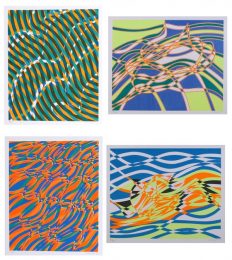

1901-1988
English painter and printmaker Stanley William Hayter was one of the most significant printmakers of the 20th century. He was associated with Surrealism in the 1930s and from the 1940s onwards with Abstract Expressionism. He founded the renowned Atelier 17 studio in Paris in 1927, frequented by such artists as Pablo Picasso, Jackson Pollock, Mark Rothko, and Flora Blanc. Hayter was an innovator, playing a large role in the development of viscosity printing with oil-based inks. As a painter, Hayter created some of the most significant images of his century.
Stanley was born in Hackney, London, in December 1901, to the son of painter William Harry Hayter. He studied chemistry and geology at King’s College London and later worked in Iran for the Anglo-Persian Oil Company in the early 1920s.
He started up as an artist by chance after returning home to recover from an attack of malaria. During his recovery, his company arranged an exhibition to display the paintings and drawings Hayter had made overseas. The exhibition was a success, many of the paintings sold quickly, convincing Hayter to pursue a career as an artist.
Hayter spent a lot of time in Paris and New York City from the late 1920s onwards. During his career he collaborated with many contemporary artists such as Miró and Picasso and encouraged artists of all ages and abilities to work together.
Stanley William Hayter produced many prints, his first prints be created in the late 1950s. Most of Stanley William Hayter’ prints were etching prints though he also create many engraving prints and lithography prints. All of Stanley William Hayter prints are original prints as Hayter saw printmaking as a distinct medium to create artworks.